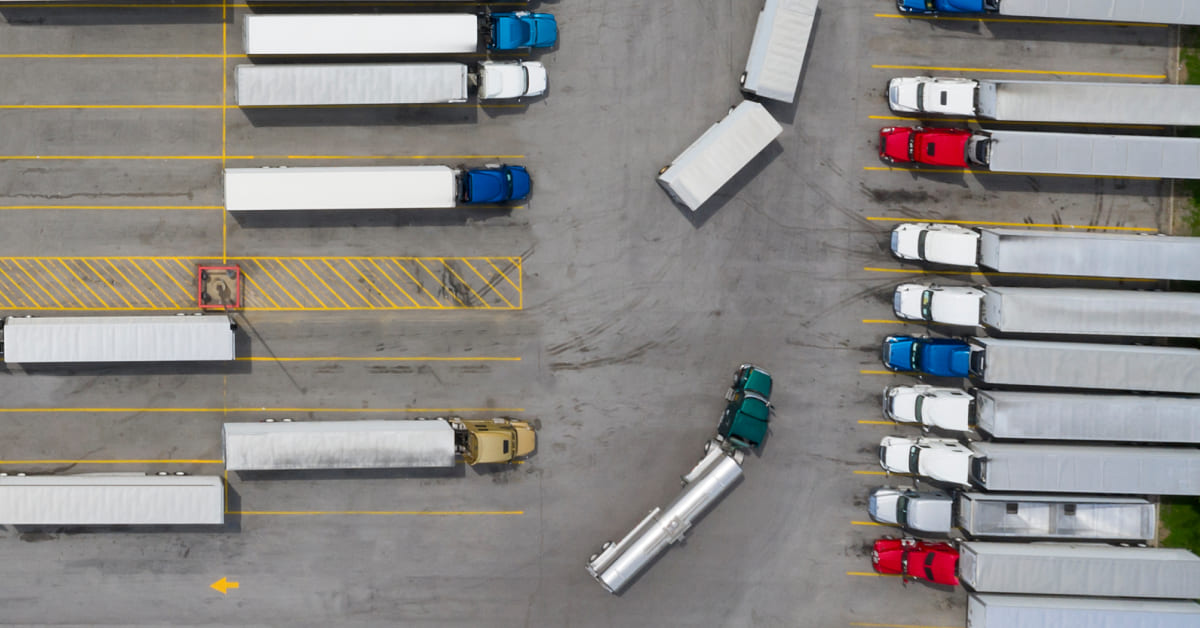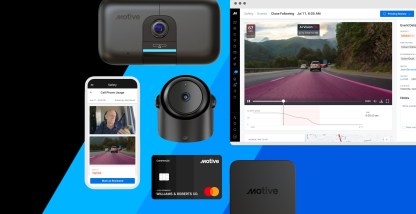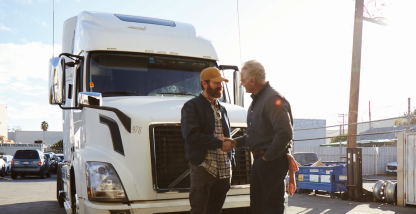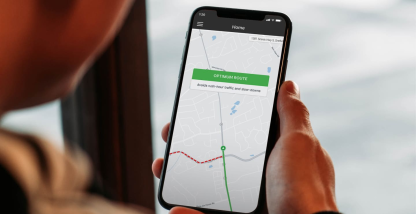Trucks transport up to 70% of all freight in the United States. This translates to billions of dollars in shipped goods annually.
With the ongoing driver shortage, rising freight demand, and increased rates, this could be a great time to learn how to start a trucking company. We’ve put together a cheat sheet on how to start a trucking company and grow a successful trucking business.
Overview on how to start a trucking company
There are a lot of positives to running a trucking business. You can choose which companies to work with. Decide what load to haul. And how often you’ll make the runs. You may also be paid better since you own the company and get a bigger share of the profits.
Despite all these benefits, it’s worth pointing out that starting a trucking business can be quite overwhelming.
This guide is for you if you want to learn how to start a trucking company.
1. Planning and preparation
Getting started with your own trucking business involves a lot of planning and preparation.
The usual approach is to start as an owner-operator, which means you should have your own truck as well as participate in the daily activities of your fleet. Many new owner-operators start out as drivers themselves.
If you don’t have industry experience, you must first secure the appropriate type of commercial driver’s license. You may also choose to hire other truck drivers.
Regardless of how you want to structure your fleet, thorough planning is essential.
Picking a name for your trucking business
Deciding on your trucking business name is also crucial. Brainstorm some ideas. Then make sure no other companies share the same name. You can check by using business name search tools or performing a trademark search online. If you want a business name that excludes your first and last names, file a DBA (doing business as). Or, set up an LLC or other entity with your business name.
Selecting a target market
Targeting the right market niche is crucial to starting a trucking company. Becoming a niche carrier may help you avoid competing with large haulers, establish your name in the industry, and optimize your sales opportunities.
Specialized trucking niches can help you streamline your operational processes and resources. As opposed to “anything to anywhere” freights, which can be too dynamic and expensive for startups.
To select a niche before you start a trucking business, ask yourself the following questions:
- Which products, industries, or companies in my target locations and shipping lanes do I find interesting? If I invest sufficient time and energy to learn about the niche, will I enjoy it?
- Which shippers give me the most positive reviews?
- What goods and logistical activities am I already aware of? What are their most critical needs and requirements? How can I meet them better than other haulers?
- Who will my trucking company’s services benefit the most?
- Who are my ideal customers and shippers? What are their needs, strengths, and weaknesses? As their niche carrier, how can their operations benefit from my services?
Identifying your rates per mile
Another part of planning your trucking business is identifying the right rate per mile that you’ll charge. It should be high enough for you to make a profit, cover operational expenses, and compete with the price that brokers charge your shippers.
Follow these steps to determine your rate per mile:
- Choose your freight lane.
- Proceed to a load board.
- Look for 10 loads going the same direction.
- Contact the brokers to see how much they’re paying.
- Compute the average.
- Add 10-15% to estimate the price brokers bill shippers.
- Repeat the steps for loads going in the opposite direction.
2. Creating a trucking business plan
A carefully crafted business plan makes the process of starting a trucking company a lot smoother. It specifies your business processes. Such as your sales and marketing strategies, pricing, operational activities, fleet management, and more.
It should also include your company goals and the financial, human, and material resources needed to achieve your targets.
A business plan can also help articulate the type of trucking business you intend to run. Below are some questions you can ask yourself to create a well-rounded business plan for your trucking business:
- Do you plan on being an owner-operator?
- Will you concentrate on short-haul or long-haul trucking?
- Should you purchase trailers or procure them through an operating lease?
- What are your financial forecasts?
- Have you allotted a budget for ancillary expenses?
- Do you plan to expand in the future?
You can use two specific formats for crafting a trucking business plan:
Traditional business plan format
A traditional business plan is comprehensive and may include the following:
- Company description
- Market analysis
- Marketing and sales
- Service business analysis
- Sales strategy
- Financial projections
- Personnel plan
- Management and organization
- Executive summary
Lean startup format
Companies that anticipate future changes may use the lean startup format. As the name suggests, it requires fewer details than a traditional business plan and is more flexible.
A lean startup plan may include:
- Key activities
- Key partnerships
- Key resources
- Customer segments
- Value propositions
- Cost structures
Visit the U.S. Small Business Administration website to access their downloadable templates for a more in-depth business plan.
3. Legal requirements when you start a trucking business
In addition to a valid CDL (commercial driver’s license), owner-operators must also fulfill a number of requirements outlined by the FMCSA.
Below are some of the permits a trucking company may need:
USDOT and Motor Carrier (MC) authority numbers
The USDOT number tracks your regulatory compliance and safety records. The MC number is also known as “operating authority.” It classifies your trucking company and the cargo you can carry.
To obtain your USDOT and MC numbers, register your business with the Federal Motor Carrier Safety Administration (FMCSA). You must also accomplish the Motor Carrier Identification Report (MCS-150) and Safety Certification Application.
After filing your application, you’ll acquire your USDOT and MC numbers, but the FMCSA still needs to review it by posting your application on the Federal Register for a “mandated dispute period” of ten business days, seeking out any public comment that might rebut your request.
Unified Carrier Registration (UCR)
The UCR system validates active insurance coverage within every state the trucking company operates. Register your company in the program using your USDOT and MC numbers.
International Registration Plan (IRP) license plate
The IRP plate released by your trucking business’ home state permits you to operate in all states in the US, including most Canadian provinces. This license plate requires you to pay annual renewal fees.
Heavy Highway Use Tax Return (Form 2290)
If your business uses trucks weighing at least 55,000 pounds on the highway, you should comply with the IRS in paying the Federal Excise Highway Tax or heavy highway vehicle use tax.
Complete Tax Form 2290 annually with the IRS to settle your tax dues.
International Fuel Tax Agreement (IFTA) permit
This rule permits your business to get one fuel license. It also mandates you to file fuel use tax returns quarterly in the state your business is based in.
BOC-3 Form
Designating a process agent is a requirement to obtain interstate operating authority. A process agent can serve legal documents and is in every state your business operates.
Register an updated BOC-3 Form with the FMCSA to appoint that agent.
Weight/distance travel permits
If you’re planning to transport goods to the states of Kentucky, New Mexico, New York, or Oregon, you should comply with their weight/distance taxes and hold an account there to assess and settle the taxes.
Standard Carrier Alpha Code (SCAC)
The SCAC is a standardized, unique, and privately maintained piece of code used to determine various transportation businesses.
Acquire this if you’ll carry government, international, military, or intermodal products.
Electronic logging devices
The ELD mandate was implemented in December 2017. Non-exempt carriers are required to install an FMCSA-registered and compliant electronic logging device.
4. Funding your trucking business
This part answers the question many new trucking business owners ask: “How much does it cost to start a trucking company?”
In most cases, an investment of between $10,000 and $30,000 should be enough to cover the costs of insurance, vehicle down payments, permits, and state-specific expenses.
There are many ways to finance your new trucking business, such as using a home equity credit line, acquiring a bank loan, selling properties, and using your savings. To reduce your initial overhead, you may also approach lenders who can provide you with essential assets.
5. Buying assets when you start a trucking business
If you have enough funds and decide to purchase your own assets, it’s always better to go for quality over price. Especially when it comes to commercial motor vehicles.
Paying a higher price for a brand new truck may mean fewer repairs, maintenance, and downtimes that could hurt your fleet’s profitability.
The same can be said for second-hand units that are well-maintained and are from reputable manufacturers. Here’s a list of things you should inspect before you purchase a used truck:
- Any visible signs of body damage
- Rust
- Tire tread
- The vehicle’s mileage
- The vehicle’s maintenance and oil change history
6. Insuring your assets
Every carrier needs insurance to protect their trucking business from unexpected financial burdens. This should cover risks such as damages to your vehicles and injuries caused by road accidents.
You may consult trucking forums and social media communities for recommendations on which insurance product to purchase based on your needs.
For more information on legal insurance requirements, check out the FMCSA’s insurance filing requirements.
7. Preparing your trucks for the road
Before commercial vehicles are allowed to haul cargo, carriers must prepare for one last set of requirements.
On top of your USDOT number and the company’s registered name decals on your vehicle, you also need your Radio Frequency Identification tags displayed on your windshield.
Also, you shouldn’t forget your license plates or International Registration Plates if you operate across multiple states.
8. Hiring and retaining drivers
Recruiting and retaining good drivers is a challenge.
According to the American Trucking Associations, the driver turnover rate for large truckload carriers jumped to 94% in 2018. That’s 20% higher than the turnover rate in Q1 2017. For smaller carriers, the driver turnover rate is 73%.
A solid driver retention strategy begins with an effective driver recruitment process. Use a Pre-Employment Screening Program to view a prospective driver’s crash data for the last five years and roadside inspections for the last three years.
For driver retention, focus on driver happiness and fulfillment instead of cash-based incentives. When offering performance-based rewards, use ELDs and driver safety scores to rank drivers according to performance, safety, and efficiency.
Hiring good drivers and retaining them will play a key role in the growth of your trucking company. Therefore, it’s highly recommended that you have a thorough strategy for driver recruitment, driver satisfaction, and driver retention.
8. Establishing fleet management processes
When you start a trucking business, it’s crucial to establish your fleet management systems because they affect several aspects of your trucking operations, such as:
- Vehicle maintenance
- Supervision of driver behavior and practices
- Compliance
- Fleet safety
- Fuel management
As your fleet grows, managing vehicles can become more challenging. That’s why you should streamline your fleet administration by using fleet management software.
Examples of fleet management processes include:
- Driver safety benchmarks
- Monitoring vehicles for potential maintenance issues.
- Setting up driver coaching programs to encourage safe driving habits, discourage vehicle idling, etc.
9. Growing your client base
Staying loyal to one customer might seem reasonable, but it may not be sustainable in the long term. You need to diversify to stay profitable. Regardless of the individual financial standings of your clients.
A good rule is to make sure a single client doesn’t account for over 20% of your revenue. This means you should have at least five clients sending you a constant supply of loads.
To attract more clients, use online freight boards. Build a company website and network. And make sure to have social media presence.
Freight boards or load boards bring together shippers and carriers in an online marketplace. Here, shippers can post their available loads. And carriers can find which ones they can haul.
Look for high-paying freight loads and the right clients to retain and increase your profitability. Get reputable shippers that pay considerably and promptly, offer deliveries matching your freight lanes, and provide loads regularly.
When building your trucking business website, remember your goal is to impress, educate, and engage your prospects. Write valuable, professional, and updated content. Include relevant details about your trucking company and the services it offers. Wow website visitors with original, high-resolution photos and images. Get hosting services that can handle your increasing traffic.
Network with shippers both online and offline through LinkedIn, truck shows, and regular transactions. Don’t forget frequent correspondence and personal meet-ups too. You must foster a good working relationship with your clients so they’ll stay and support your business.
Finally, widen your reach further by being active on social media. Publish high-quality content, promptly answer inquiries, and interact with your followers on social media sites. You can even run ads on platforms to acquire business leads and grow your list of customers.
10. Growing your trucking company with the right tools
Successfully running a trucking company isn’t easy, but it may become more manageable with the right tools. For example, you can:
- To help with your various fleet manager responsibilities, use fleet management software that can help you easily manage multiple areas of your trucking business.
- Use an ELD solution to comply with the FMCSA ELD mandate.
- Use a freight load board to find loads and grow your client base.
- Use real-time GPS tracking and geofencing for route optimization, cutting down fuel expenses, and reducing detention time.
- Install AI-powered dash cams that can help improve driver safety and even exonerate drivers when they aren’t at fault.
For instance, the Motive AI-Powered Dashcam enables you to see what your drivers see on the road.
With relevant video footage, you can exonerate drivers when they aren’t at fault, simplify insurance claims, promote a culture of safety, and protect your trucking business from the uncertainties of the road. Otherwise, even a single road accident can financially cripple your trucking business.
Case Study #1: Read how Nybll avoided a personal injury lawsuit with dashcam footage that could have cost up to $500,000.
Case Study #2: Read how Tri-Pol Enterprises cut down their insurance renewal rate from 45% to just 17% and reduced their operational expenditures.
Download the ultimate guide on how to start a trucking company
Get the right tools to help with your new trucking company, call us at 855-434-3564. Our 24/7 support team is available to answer your questions.










